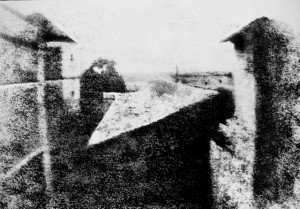
World’s earliest surviving camera photograph, 1826 or 1827. Still, it’s clearer than many of my photos.
Credit: Wikimedia Commons
It may be a difficult thing to fathom in this age of cloud storage and flash drives, but there was a time not so long ago where printing was an inseparable part of the photographic process. Back in the days of film cameras, when you took your pictures the film then needed to be developed into a negative, and all that effort was kind of pointless unless you were actually going create an actual print from the negative.
Of course, printing from negatives is not dead, by any means; it lives on thanks to lomography and other more esoteric forms of photography. Not to mention my Dad, who recently showed up to a family reunion at a beautiful resort with a disposable film camera, despite the fact that he has a brand new iPad that he knows takes amazing photos yet refuses to so much as experiment with it…but, I digress. My point is that anyone who prefers shooting film for any reason can still have it developed by the Photolab.
In any case, if you are old enough to remember back when film and printing were standard operating procedures and clouds were nothing more than puffy things that looked like unicorns, here’s a little photo-print-related trivia to test the extent of your knowledge on the subject:
When was the first photographic image developed? (Answer honestly; off the top of your head, no looking it up on Google.)
Had enough time to think about it? Time’s up! The answer:
It was commercially introduced in 1839, a date generally accepted as the birth year of practical photography. The metal-based daguerreotype process soon had some competition from the paper-based calotype negative and salt print processes invented by Henry Fox Talbot.
Source: https://en.wikipedia.org/wiki/History_of_photography
So, there’s your definitive answer…or is it? National Geographic credits French Scientist Joseph Nicéphore Niépce with taking the first photograph ever in 1826. However, this article from the Metropolitan Museum of Art also cites January 7, 1839 as the date Daguerre presented his daguerreotype technology to members of the French Académie des Sciences (and March 9, 1839 as the date his laboratory burned down, destroying his work and records).
Regardless of when the first photo was actually produced or who gets most of the credit for it, it was Henry Fox Talbot who pioneered the process of chemically developed film negatives that would become the standard for photo printing:
With the negative image, Fox Talbot realised he could repeat the process of printing from the negative. Consequently, his process could make any number of positive prints, unlike the Daguerreotypes. He called this the ‘calotype’ and patented the process in 1841.
Source: http://www.bbc.co.uk/history/historic_figures/fox_talbot_william_henry.shtml
Since his calotype process made photography more practical than illustration or paintings, and made it accessible to everyday people around the world, I’m giving it to Talbot in 1841. Feel free to disagree!
Here’s something else to think about: if he were alive today, what would Henry Fox Talbot think about the incredible proliferation of photography that’s taken place as a result of the digital camera, particularly the smartphone? I imagine he would be fascinated by it, but at the same time somewhat heartbroken that it has taken the printing technology that he spent countless brain cells inventing and perfecting and turned it into a non-essential part of the process. I also imagine that if he ever envisioned something called a selfie stick, he would have given up inventing altogether and stuck to archaeology.
So as you celebrate World Photo Day, remember: every time you take a great photograph, upload it to social media and leave it at that, you give Henry Fox Talbot a bad case of heartburn from beyond the grave. Don’t waste the wondrous technology he gifted us, especially not today. Upload your best photos to the Photolab, and print them out in any number of ways that would make photography’s great historical benefactors proud.

